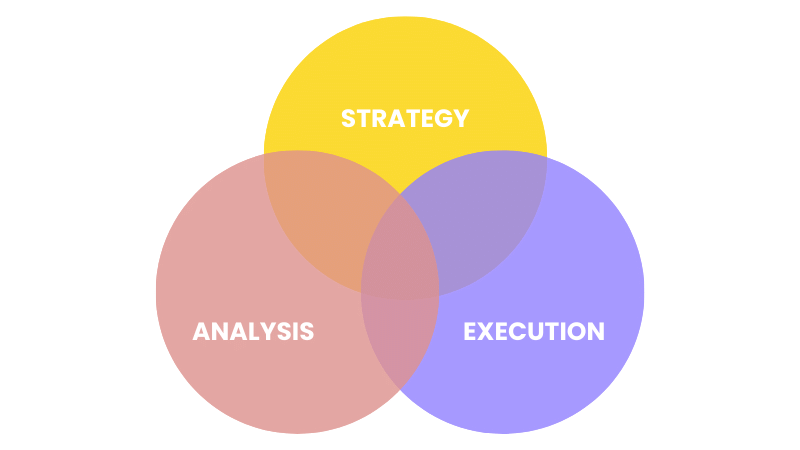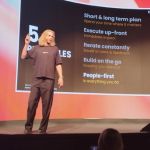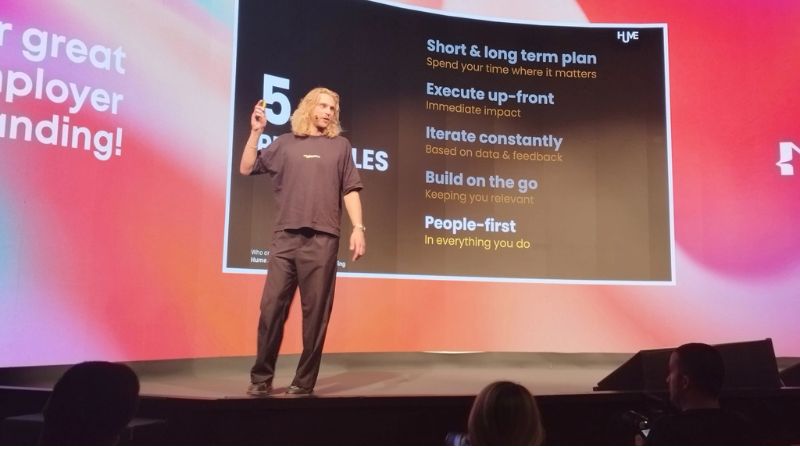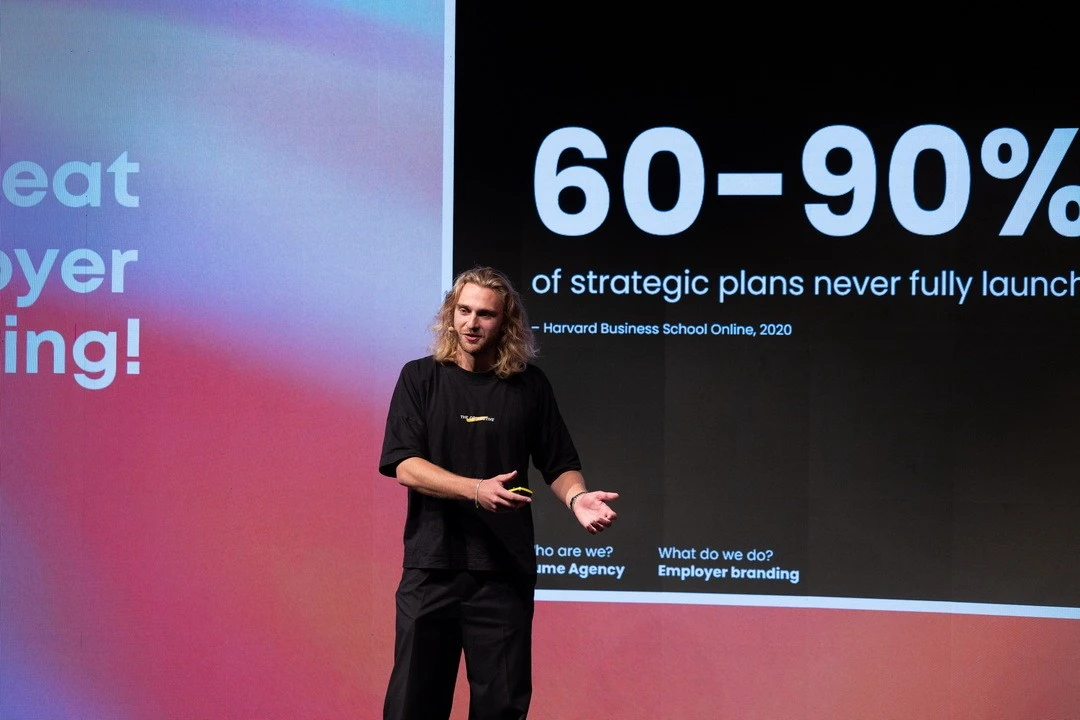Introduction
In Denmark, having a solid employer brand is essential if you want to stay relevant. At Hume Agency, we craft targeted strategies for startups and scaleups, helping them attract the right talent and customers. And no, by that, we don’t mean +6 months of strategy creation without any action. We’re all about execution and strategy creation on the go based on real-time data and feedback.
Ready to build a top-notch employer branding strategy? We’ve broken it down into ten clear steps. Here’s the first part of that journey. Dive in.
1) Embrace Radical Transparency
In the digital age, transparency is not just a virtue but a necessity. Cultivating a culture of openness can pave the way for fostering trust and establishing a brand that resonates with both employees and customers. In this section, we’ll unveil how to embrace transparency adeptly, thus laying a solid foundation for your employer branding strategy.
Showcase Real Stories
Provide your audiences with real stories and testimonials from your existing teams. Real narratives can craft a vivid picture of your organizational culture, fostering a sense of reliability and authenticity.
The most important part?
Don’t stop with the initial superficial question and answer. Dig deeper and uncover the stories that will drive attention from the real world.
Open Dialogue
Foster an environment where dialogue is encouraged. An open-door policy where employees can freely voice their opinions and suggestions can be a game-changer in building a transparent culture.
2) Reframe Your Thinking About Employer Branding
The first step towards building a robust employer brand is fundamentally altering your perspective about employer branding. Sounds funny, we know… In this part, we reveal the essential facets of reframing your thoughts to build a radical and effective strategy.
Beyond Just Recruitment
Understand that employer branding is not confined to recruitment alone. It covers the world’s perception of your organization. Yes, also customers and investors. Think of your product brand as “Is this something I would buy and how would it make me feel?” while employer branding is more like “Are these people someone I could see myself surrounded with on a daily basis?”. As you see, this goes to both candidates, customers, and investors. Show the world that you are competent and not douchebags.
Building a Story
Every brand has a story. Delve deep into your organization’s journey and carve out a compelling narrative. This story, laden with your company’s milestones, culture, and ethos, can be a powerful tool in attracting the right people.
Leveraging Data
Harness the power of data to refine your strategies continually. Don’t think building a strategy is a one-time thing. You have to keep iterating based on your culture, the market, and the world. Utilize insights and analytics to understand the changing dynamics of the job market and to tailor your branding strategies accordingly.
Employer branding is not a one-time affair. It requires constant nurturing and adaptation to the changing dynamics of the job market. A Deloitte Insights article emphasizes data analytics’s critical role in understanding market dynamics, helping companies make informed decisions that align with their branding strategies.
3) Understand Your Business and Talent Needs Upfront
Starting your company’s strategic employer branding journey necessitates a clear understanding of your business and talent needs. This section discusses the critical aspects to consider when identifying these needs and how to align them proficiently to build a formidable brand.
Identifying Skill Gaps
Take a proactive approach to identifying the skill gaps within your organization. A LinkedIn study indicates that 87% of HR professionals agree that candidate skills are evolving faster than ever before. A clear understanding of the competencies you require can guide you in devising targeted recruitment strategies. Explore our article on the real-time revolution in strategy creation to gain insights into identifying and bridging these gaps effectively.
Aligning with Business Goals
Ensure that your employer branding strategy perfectly aligns with your overarching business goals. A well-aligned strategy can be instrumental in propelling your business to greater heights. According to a Harvard Business Review report, companies with aligned goals witness a significant boost in employee engagement and customer loyalty. Breaking down the silos between departments will make your life easier and strengthen your brand going forward.
Don’t overcomplicate things to begin with. If you know your talent and business goals, you can start initiatives that support those. Based on your initial initiatives, you’ll gather feedback, insights, and data to drive the creation of your strategy forward. It’s a beautiful cycle.
Creating a Talent Persona
Develop a clear talent persona that encapsulates the qualities and skills you desire in potential employees. This persona can serve as a blueprint for attracting the right talent that resonates with your brand.
Engagement and Retention Strategies
Devise strategies that not only focus on attracting the right talent but retaining them as well. Implement engagement initiatives that foster a nurturing work environment, encouraging employees to grow with the organization.
In this journey of creating an employer brand that resonates profoundly within the Danish business environment, embracing radical transparency and reframing your perspective about employer branding are the initial yet crucial steps. With a clear understanding of your business and talent needs, you are well on your way to crafting a brand that crushes competition. Stay tuned as we unravel more layers of this transformative journey in the upcoming sections, where we delve deep into creating impactful initiatives, leveraging data, and much more.

In the second segment of this guide, we delve deeper, focusing on strategies that center around creating an immediate impact while laying the groundwork for a formidable long-term strategy. So, let’s further explore this path to attain a dominant brand presence.
4) Create Short-Term Initiatives That Drive Impact Upfront
Creating short-term initiatives that resonate with your target audience can be the catalyst for a sustained, positive employer brand image. Let’s uncover how these initiatives can be crafted to create a resonating impact.
Building Quick Win Campaigns
Launch campaigns that showcase your brand’s strengths swiftly. These might include spotlighting employee achievements or unveiling new, exciting projects your team is working on.
Make sure to focus your efforts. If you are looking for more software developers than marketers, start there.
Provide your desired talent pool with stories of the people within your organization that they can mirror themselves in to improve your attraction rate.
Utilizing Social Media Platforms
Social media platforms are different and should be used accordingly. LinkedIn is great for sharing thought leadership pieces or providing a quick behind-the-scenes view to showcase your company culture.
Instagram is a great place to let employees run the show. This platform is also great at sharing internal stories and works great for internal purposes. Encouraging an engaging and alive Instagram profile is a great way for colleagues to stay close to what’s happening and feel included in the culture.
TikTok is a great way to test out content themes. The platform screams for low-quality, high-authenticity content, making it a perfect place to try out content themes without breaking your budget. The platform offers the highest engagement rates, which can be used to your advantage. Learn from the data and double down on the audience-proved content themes. Be creative and repurpose the content for other platforms. Work smart, not hard.
Think of the capabilities of the different platforms, look at your business goals, and begin producing the places that make sense. If you’re low on resources, start posting content on one platform at a time.
Employee Advocacy
Encourage your employees to become brand ambassadors. Through testimonials or sharing their work experiences on platforms like LinkedIn, employees can offer a personal perspective into your company’s vibrant culture.
5) Study Insights, Data, and Feedback to Build the Long-Term Strategy
In the long run, your employer brand’s strength lies in its ability to adapt and grow. Here, we illustrate how to create a feedback loop that fuels continuous improvement.
Harnessing Employee Feedback
Create channels where employees can freely share their feedback and insights. This feedback can be a rich resource in understanding the areas where your brand can enhance and evolve.
Analytics and Insights
Invest in analytics tools that can provide deep insights into the performance of your branding strategies. Analyzing data can help you tweak your strategies to suit the changing market dynamics.
For LinkedIn, we recommend using the Shield App to track individual posts from employees.
Collaborative Approach
Adopt a collaborative approach where different departments work together to build a cohesive brand image. Sharing insights and data across departments can lead to more rounded and informed strategies.
P&C has lots of insights into the culture. Marketing has the competencies to get it in front of the right people.
6) Ensure Differentiation
In a competitive market, differentiation is key. Let’s explore the facets that can make your brand stand out amidst the competition.
Unique Value Proposition
Here, we’re not talking about an EVP. Not yet, though. An Employer Value Proposition can be a great tool to tie everything together. But remember, when starting out, you don’t have all the pieces yet.
Here, we’re talking about understanding what differentiates your company and finding the right way to communicate that.
Look at your target audiences’ preferences when joining a new company and your strengths as a company. Find the bridges and test different value propositions. Test, look at feedback, and optimize.
Content Strategy
Devise a content strategy that mirrors your brand’s unique attributes. From blogs to videos, create content that resonates with your target audience and highlights your differentiation points.
By adopting a radical approach that emphasizes immediate impact and long-term strategy building, your company can carve a niche in the Danish market. Remember, creating short-term initiatives with immediate impact, harnessing data and insights for long-term strategy, and ensuring differentiation are vital steps in this journey.

In this section, we will explore strategies that help nurture a proactive organizational culture and emphasize the vital role of corporate responsibility and perpetual refinement in building a resilient brand.
7) Evaluate Your Firm’s Culture and Offering Proactively
It kinda goes without saying, but to help you work strategically with employer branding, you have to stay up to date with your internal offerings. More importantly, you should always encourage internal feedback. There are many ways of gathering feedback from your colleagues, but the most important part is that you do.
Employee Engagement Surveys
Implement periodic employee engagement surveys to take the pulse of your organization. These insights can be vital in making informed decisions and fostering a better and better work culture.
Leadership Training Programs
Bad leadership is one of the biggest reasons for employees leaving a company. It’s critical to keep a sharp eye on the development of your management. These leaders can be pivotal in steering the organizational culture in the right direction.
Employee Benefits
Don’t just blindly pick some benefits because it sounds nice or because that’s what you’ve seen in other places. Involve your colleagues. What benefits would actually improve their daily lives? You might be surprised. There are cases where companies have spent less money and improved employee well-being just by asking what people want. It’s a funny world we live in…
8) Showcase Your Corporate and Social Responsibility
It quickly becomes a buzzword, but it’s expected today. A hack is to explain deeply how you work with “social responsibility”. Simply saying the word will catapult your brand in the completely wrong direction.
Community Engagement
Engage with the local community through initiatives and programs that underscore your commitment to societal well-being. Be it environmental conservation or educational programs, let your brand be synonymous with positive change.
Sustainability Initiatives
Integrate sustainability into your business operations. Showcasing efforts such as waste reduction, energy efficiency, or supporting sustainable causes can significantly enhance your brand image.
Collaborations with NGOs
Forge collaborations with NGOs and other organizations to contribute positively to society. Such partnerships can amplify your reach and impact besides adding a commendable facet to your brand narrative.
Again, it’s important to state that simply saying the above won’t do shit. Actually, it will destroy your brand. Greenwashing is not cool. Find responsible ways to work socially responsible and provide examples of how you do it. That will set your brand apart.
9) Continuously Refine and Adapt Your Employer Branding Strategy
Employer branding should be a dynamic sport. To remain ahead, a brand must be willing to continuously adapt and refine its strategies. Let’s discover the strategies that foster flexibility and innovation in your branding approach.
Feedback and Iteration
Adopt a culture of continuous feedback and iteration. Be willing to modify strategies based on the changing market dynamics and employee expectations.
Leveraging Technological Advancements
Harness the potential of technological advancements to stay ahead with the latest trends in employer branding. Be it utilizing AI for recruitment or implementing advanced data analytics, let technology be your ally in this journey.
Learning and Development Programs
Establish learning and development programs that encourage employees to build their skills continually. A brand that invests in the growth of its employees resonates profoundly in the job market.
10) Building Trust through Authenticity
In conclusion, the cornerstone of a successful employer branding strategy is building trust through authenticity. Let’s explore how fostering genuineness can cement your brand’s position in the market.
Authentic Communications
Embrace authentic communications that resonate with your audience. Whether it is showcasing real stories or adopting transparent practices, let authenticity be your guiding principle.
Building Community Connections
Focus on building community connections where your brand can foster a sense of belonging and camaraderie among employees and the wider community.
That kind of raps it up. This was a long haul, but we hope you got something from it. The key aspect is that strategy creation shouldn’t be a static practice. Focus on setting objectives, execute up-front, and learn from feedback and data. Use this information to set a scope for the long run and JUST. KEEP. MOVING.
If you want this content straight in your feed then let's connect on LinkedIn!
Jonas Molbech
Co-Founder of Hume Agency





